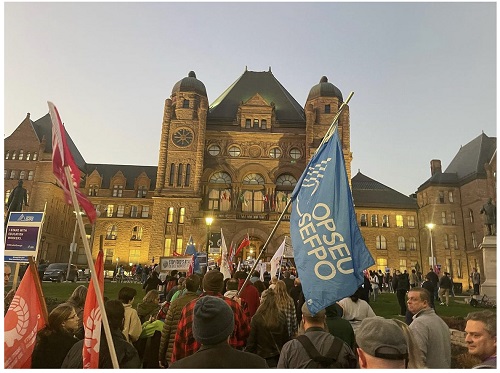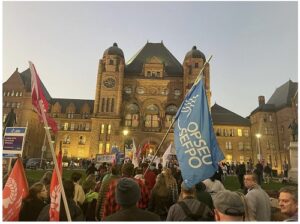School, Ontario Labour Board to rule on legality of strike
TORONTO – It is open war between the Government of Ontario and the Canadian Union of Public Employees (CUPE). On Friday, the first day of the strike by the 55,000 union members employed in schools, thousands of people demonstrated outside Queen’s Park and the offices of Conservative Party provincial MPs. Schools in the province will still be closed tomorrow and, according to union leaders, will remain closed until a collective agreement is signed with the government.
But Prime Minister Doug Ford and Education Minister Stephen Lecce are not going to stand idly by and have asked the Ontario Labor Relations Board to officially declare the current strike illegal.
After Saturday’s hearing that lasted for more than 14 hours, today the discussions between government lawyer Ferina Murji and CUPE’s legal team created an incandescent atmosphere. The decision of the Ontario Labor Relations Board is expected shortly.
Meanwhile, many school boards of the province, unable to guarantee the safe conduct of lessons due to the absence in schools of educational assistants, custodians and librarians, have decided to close school buildings and switch to distance learning for the duration of the protest.
Even before the strike began, the Ministry of Education sent a note to school directors asking them to make “every effort” to keep schools open for as many children as possible. In the note, the ministry called for supporting students in a rapid transition to synchronous distance learning. Compared to asynchronous learning, which sees students watch pre-recorded video lectures, complete assignments, or contribute to online discussion forums, synchronous learning involves real-time live online teaching.
Most school boards in Greater Toronto and the Hamilton area have announced plans to close schools and transfer students to online classes for as long as necessary.
Only the Halton School Board (HCDSB) has decided that elementary school students will alternate between in-person and virtual learning.
The inconvenience that parents and children will face due to the strike are enormous but CUPE has no intention of taking a step back.
It should also be remembered that the new law passed by the Ford government – the Keeping Students in Class Act – provides fines for violating the strike ban of up to $ 4,000 per employee per day – which could amount to $ 220 million for all 55,000 workers – and up to $ 500,000 per day for the union. CUPE has already said that it will contest the fines, but that it will pay them if necessary.
Meanwhile, other unions run to the rescue of the CUPE of the province with demonstrations and financial support. The British Columbia Teachers’ Federation, for example, tweeted that it would send CUPE Ontario $1 million to help pay the fines. This donation comes a day after Unifor pledged to give $100,000 as a demonstration of its support.
The government and the union initially started negotiations in July, before the expiration of the contracts of education workers on August 31: after almost four months the parties are still very far away, the salary increase in particular represents the obstacle that seems insurmountable.
In the pic, the protest at Queen’s Park (Twitter: @opseusefpo)




